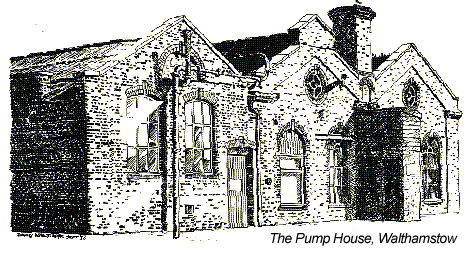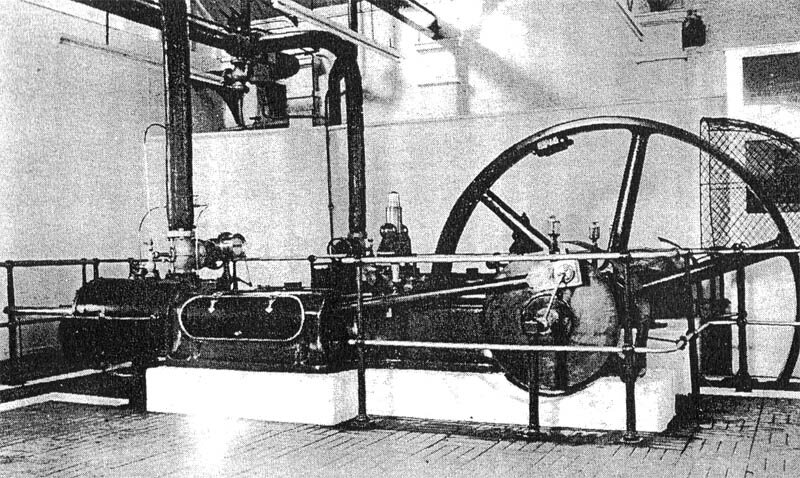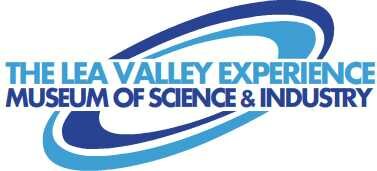Development of the Project:The Pump House Steam & Transport Museum Trust

An illustration of the Low Hall Pump House in 1994
The Lea Valley Experience Museum Project, Walthamstow
The Lea Valley Experience Project the project is currently being developed in and around the former engine room and pump house complex of the old Grade II Listed Walthamstow's Victorian sewage treatment works.
Our aim is to restore the building and machinery back to their former glory, and to develop a series of exhibits and displays illustrating the development of the Lea Valleys industrial and transport achievements, which are of national and world importance. More buildings will be constructed to house additional exhibits and displays at a latter date.
The Pump House 1885 the two original pump house bays and additional buildings (below) date from 1885. Only the 2 bays to the left and a small section of the building to the right exists today.
The building was constructed of London stock brick with blue engineering bricks around the doors and windows.
The two Hayward Tyler steam pumps that moved the effluent were situated in a pit at the front end of the building. The steam power was generated by two boilers situated in the left bay.
It is also recorded in the Councils minutes of 1885 that Tangyes of Birmingham also installed a single horizontal engine for the cost of £420 which was situated next to the pit, however, what this engine was installed for still remains a mystery today despite research.
Accommodation for the chief engine room attendant was provided in No. 1 Farm Cottages in Acacia Road at a rent of 10/- per week.
The pump pit was filled in during the 1970s and is currently being excavated
The Pump House 1896
In 1896 the two 1885 bays were enlarged and a third bay was added to the left of the building. The Marshall C class steam engines, boilers, and plant equipment were also added at this time; however no plans of the 1896 extension have been found to-date.
Tenders were invited by the Council in early 1896 for designs on a way to connect the new Marshalls engines with the original 1885 Hayward Tyler steam pumps.
We have presumed that this must have been successful and the engines did in fact power the pumps via overhead line shafting, of which can still be seen today.
In addition to this various pieces of workshop equipment were placed in the pump house. The engines also provided the power to drive these machines. Originally fuelled by coal, the steam plant was converted in the early 1900s to work from domestic refuse which was burnt elsewhere on the site.
However, by the early 1970s the general state of the boiler made the raising of steam then a rather haphazard affair. The installation of electrically powered pumps then sealed the engines' fate, and a large part of the 1885 buildings was demolished The Great Eastern Railway also provided a connection to the site from Lea Bridge Road. The site also had a small locomotive shed and locomotive at one. From 1928 the pumps moved sewerage directly into the LCC sewerage system. time.
The Pump House Today
the pump house today contains what are believed to be the only surviving pair of "C" class horizontal steam engines built by the Lincolnshire firm of William Marshall Sons & Co.
• The engines are also Grade II listed along with the steel beams within the building.
• The installation of these engines and a boiler cost £220.
Today, Marshalls are best remembered as builders of traction engines, but in their nineteenth century heyday the firm produced an extraordinarily diverse range of products, from threshing machines to tea plantation equipment.
The two engines bear the makers numbers 27834 and 27835 and were installed in the pump house during the spring of 1897, being steamed for the first time in May of that year.
The engines were not designed to (and cannot be) run together rather, one engine would have worked for two weeks running continuously whilst the other received maintenance.
It would have taken about forty minutes to disconnect one engine from the flywheel and to connect the other. This process was generally carried out in the early hours of the morning when the sewerage flow was at its slackest.
The Low Hall Manor and the Farm
the area now occupied by the Museum was purchased from the Bosanquet family in 1877 by Walthamstow Urban District Council.
Prior to this, the 200 acre site had been farmed from at least the early mediaeval period (traces of a moat which surrounded the mediaeval manor house and farm survived until comparatively recently).
Although the site is therefore of considerable antiquity, today nothing remains above ground of the original seventeenth century manor house and farm as they were both completely destroyed by a flying bomb in 1944.
In 1997 the site was excavated by MOLAS (Museum of London Archaeology Service), and a number of interesting artefacts were found. It is proposed to display some of these at the museum in the future.
The Future
when the pump house became redundant in the 1970s, the concept of an industrial museum was conceived. Also happily, unlike so many others, the engines were not scrapped.
The museum is currently run by the Trust, supported by Volunteers and the Friends of the Museum.
The full restoration of the Pump House has now begun and should be completed by the summer of 2009 when part of the building is expected to be open to the public.
It is also proposed that both the Marshall engines will be fully restored by then, with one engine running on steam and the other running on compressed air.

The 1896 Marshall Horizontal C Class Steam Engines in 1978 (Photo by David Perrett)






